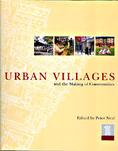commerce fragile territories downtowns urban design renaissance digitalization surveys & analyses fabrication cartography strategic planning historic centers job settlements globalization smart city culture rural areas populations housing waterfronts & harbors urban regeneration representation industrial sites citizenship design
Urban Villages: The Making of Community
Peter Neal
The Urban Village movement grew from a desire for change- it offers an alternative and time-honoured approach to the creation of successful and sustainable urban communities. For decades owr towns and cities have suffered from intense economic and social deprivation. Many urban areas have witnessed near total collapse of a manufacturing and industrial base on which, paradoxically, many of our gratest cities were originally built. This has left a daunting residue of soulless housing estates, home to unemployment, crime, drug-abuse and social exclusion. The common response has been to turn our back on these failing cities; creating, in contrast, vast swathes of land-hungry and characterless suburban sprawl and relocating commercial activities to drive-in retail parks on the edge of town. Now the problem has become the solution as we embark on an urban renaissance that seeks to re-establish our towns and cities as great places to live. Central to its success will be the fundamental role played by the neighborhood, for it is at this scale that communities can be established and a sense of security, sociability and economic purpose can be formed.
Urban Villages and the Making of Communities describes the principles and process of creating attractive, socially diverse and economically sustainable mixed-use neighborhoods. It addresses issues of their strategic planning, physical design, transport and connectivity, social strusture, implementation, funding and long term management. It restates many of the authentic urban precedents of successflu neighborhoods that have been ignored in recent decades and responds to the key drivers of urban change identified by Lord Roger’s Urban Task Force. An international perspective is provided, drawing parallels with the New Urbanist movement in the United States, and case studies of succeeful urban neighborhoods in Britain, Europe, America and Australia.




Planum
The Journal of Urbanism
ISSN 1723-0993
owned by
Istituto Nazionale di Urbanistica
published by
Planum Association
ISSN 1723-0993 | Registered at Court of Rome 4/12/2001, num. 514/2001
Web site realized by ChannelWeb & Planum Association | Powered by BEdita 3

